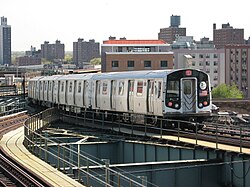R143 (New York City Subway car)
| R143 | |
|---|---|

An R143 train on the
|
|

Interior of an R143 car.
|
|
| In service | 2002-present |
| Manufacturer | Kawasaki Heavy Industries |
| Built at | Yonkers, New York; Lincoln, Nebraska; and Kobe, Japan |
| Family name | NTT (new technology train) |
| Constructed | 2001-2003 |
| Entered service | February 12, 2002 |
| Number built | 212 |
| Number in service | 208 (160 in revenue service during rush hours) |
| Formation | 4-car sets (2 A cars and 2 B cars) |
| Fleet numbers | 8101-8312 |
| Capacity | 240 (A car) 246 (B car) |
| Operator(s) | New York City Subway |
| Depot(s) | East New York Yard (212 cars) |
| Service(s) assigned |
– 152 cars (19 trains, AM rush) |
| Specifications | |
| Car body construction | Stainless steel with fiberglass rear bonnets |
| Train length | 4 car train: 240.84 feet (73.41 m) 8 car train: 481.68 feet (146.82 m) |
| Car length | 60.21 feet (18.35 m) |
| Width | 9.77 feet (2,978 mm) |
| Height | 12.13 feet (3,697 mm) |
| Platform height | 3.76 ft (1.15 m) |
| Doors | 8 per car |
| Maximum speed | 55 mph (89 km/h) |
| Weight | A car:83,700 lb (38,000 kg) B car:81,900 lb (37,100 kg) |
| Traction system | Bombardier MITRAC propulsion system, 3-Phase AC Traction Motors Model 1508C |
| Prime mover(s) | electric motor |
| Power output | 150 hp (111.9 kW) per axle |
| Acceleration | 2.5 mph/s (4.0 km/(h·s)) |
| Deceleration | 3.0 mph/s (4.8 km/(h·s)) (full service), 3.2 mph/s (5.1 km/(h·s)) (emergency) |
| Auxiliaries | SAFT 250AH battery (B car) |
| Electric system(s) | 600 V DC Third rail |
| Current collection method | Contact shoe |
| Braking system(s) | Dynamic braking propulsion system; WABCO RT96 tread brake system; safety brakes |
| Safety system(s) | dead man's switch, tripcock |
| Headlight type | incandescent light bulb |
| Track gauge | 1,435 mm (4 ft 8 1⁄2 in) standard gauge |
The R143 is a standard gauge New York City Subway B Division new technology (NTT) car built by Kawasaki in 2001-2003. The New York City Transit Authority owns 212 R143 cars, numbered 8101-8312, and built for an average cost of about $1.5 million per car.
The contract for the R143 was put out for bidding in January 1998. The initial contract called for 100 sixty-foot cars that would come in five-car sets. The new cars would be expected to have automatic PA announcements, high efficiency lighting, emergency intercom and customer alarms, AC propulsion motors, speedometers and event recorders, electronic information display signs, artwork, a central diagnostics monitoring system, microprocessor controlled air compressor, brake and communication systems, roof mounted microprocessor controlled HVAC, and to be compliant with ADA requirements.
Kawasaki Rail Car, Inc. was awarded a $190 million contract for 100 new B Division cars in late December 1998, with an option for 112 more cars. The new design was based on the A Division's R142A, which Kawasaki also built, and incorporated many features from the R110A and R110B prototypes. Delivery began in late 2001, and a 30-day test with one train of eight cars (8101-8108) began on December 4, 2001. According to Kawasaki, the test was "extremely successful".
R143s began running on the BMT Canarsie Line (L train) on February 12, 2002, where they have been assigned to since, and all 212 cars were delivered by March 2003. In addition to running on the L, where the R143s displaced the R40/R40As and most of the R42s, they also displaced the R42s on the M weekend shuttle service on the BMT Myrtle Avenue Line when that line became the first Eastern Division line to be placed in weekend OPTO service. The R143s on the M were then displaced by R160As in February 2008. OPTO was also tested on the L during mid-2005.
...
Wikipedia
